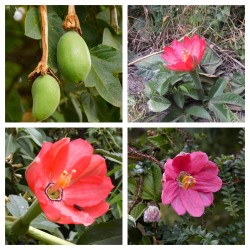Menu
-
MenuWstecz
- Home
-
Kategorie
-
-
Kategorie
-
Nasiona warzyw
-
Odmiany według kraju
- Odmiany z Armenii
- Odmiany z BiH
- Odmiany z Chorwacji
- Odmiany z Francji
- Varieties from Germany
- Varieties from Greece
- Varieties from Hungary
- Odmiany z Indii
- Varieties from Italy
- Odmiany z Japonii
- Odmiany z North Macedonii
- Varieties from Peru
- Varieties from Russia
- Varieties from Serbia
- Odmiany ze Słowenii
- Varieties from Spain
- Varieties from Thailand
- Odmiany z Turcji
- Varieties from USA
- Nasiona Pomidorów
- Nasiona kukurydzy
- Gurda rodziny
- Rodzina fasoli
- Nasiona Ogórka
- Nasiona Papryki
- Rodzina marchwi
- Rodzina cebuli
- Nasiona Sałaty
- Rodzina ziemniaków
- Rodzina kapuściana
- Nasiona Rzodkiewki
- Rodzina buraków
- Nasiona arbuza
- Nasiona melona
- Nasiona kalafiora
- Rodzina słoneczników
-
Odmiany według kraju
- Nasiona Owoców
- Nasiona Papryki Chili
- Nasiona ziół leczniczych
- Nasiona roślin pnących
- Drzewa - Krzewy - Nasiona
- Nasiona palmy
- Nasiona Traw Ozdobnych
- Nasiona tytoniu
-
Nasiona warzyw
-
-
-
-
- NOWE PRODUKTY
- Dostawa - płatność
- Utwórz konto
- FAQ
Last Product Reviews
Out of the two seeds, one germinated and the other one was dead and floatin...
By
 Riikka H on 07/03/2024
Riikka H on 07/03/2024
Verified Purchase
Jest 384 produktów.
Pokazano 346-360 z 384 pozycji
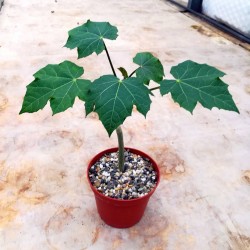
Nasiona Jatrofa...
Cena
3,75 €
(SKU: T 92)
Seeds Gallery EU,
5/
5
<h2><strong>Nasiona Jatrofa przeczyszczająca (Jatropha curcas)</strong></h2>
<h2><span style="color: #ff0a0a;"><strong>Cena za Pakiet 3 nasion.</strong></span></h2>
<b style="color: #202122; font-size: 14px;">Jatrofa przeczyszczająca</b><span style="color: #202122; font-size: 14px;">, obrzydlec przeczyszczający (</span><i style="color: #202122; font-size: 14px;">Jatropha curcas</i><span style="color: #202122; font-size: 14px;">) – gatunek rośliny z rodziny<span> </span></span>wilczomleczowatych<span style="color: #202122; font-size: 14px;">. Występuje jako roślina rodzima na obszarze Ameryki Południowej i Środkowej (</span>Argentyna<span style="color: #202122; font-size: 14px;">,<span> </span></span>Boliwia<span style="color: #202122; font-size: 14px;">,<span> </span></span>Brazylia<span style="color: #202122; font-size: 14px;">,<span> </span></span>Peru<span style="color: #202122; font-size: 14px;">,<span> </span></span>Belize<span style="color: #202122; font-size: 14px;">,<span> </span></span>Kostaryka<span style="color: #202122; font-size: 14px;">,<span> </span></span>Salwador<span style="color: #202122; font-size: 14px;">,<span> </span></span>Gwatemala<span style="color: #202122; font-size: 14px;">,<span> </span></span>Honduras<span style="color: #202122; font-size: 14px;">,<span> </span></span>Nikaragua<span style="color: #202122; font-size: 14px;">.<span> </span></span>Meksyk<span style="color: #202122; font-size: 14px;">)</span><sup id="cite_ref-4" class="reference" style="color: #202122;">[4]</sup><span style="color: #202122; font-size: 14px;">. Jest rośliną przemysłową uprawianą również w Azji i Afryce, na obszarach<span> </span></span>subtropikalnych<span style="color: #202122; font-size: 14px;">.</span><br><br>
<p style="color: #202122; font-size: 14px;">Krzew<span> </span>lub małe drzewko do 4 m wysokości.<span> </span>Liście<span> </span>długoogonkowe i sercowate rosną tylko na końcu gałęzi.<span> </span>Kwiatostan<span> </span>w<span> </span>baldachach<span> </span>wyrastający w kątach liści lub też jako szczytowe.<span> </span>Owoc<span> </span>– torebka nasienna.<br><br></p>
<h2 style="color: #000000; font-size: 1.5em;"><span class="mw-headline" id="Zastosowanie">Zastosowanie</span></h2>
<p style="color: #202122; font-size: 14px;">Roślina uprawiana dla oleju roślinnego, którego zawartość w jej nasionach osiąga 30-40%. Olej jest nieprzydatny do spożycia i stosowany może być wyłącznie do celów technicznych; wykorzystywany jest m.in. do produkcji<span> </span>biodiesla<sup id="cite_ref-5" class="reference">[5]</sup><sup id="cite_ref-america_6-0" class="reference">[6]</sup>. Nasiona mogą być spożywane po upieczeniu, poza tym roślina wykorzystywana jest do celów leczniczych</p><script src="//cdn.public.n1ed.com/G3OMDFLT/widgets.js"></script>
T 92 (5 S)

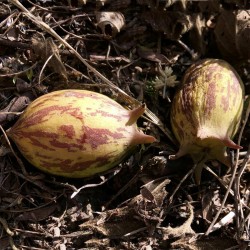
Nasiona Granadiny (Jarilla...
Cena
8,95 €
(SKU: V 105)
Seeds Gallery EU,
5/
5
<h2><strong>Nasiona Granadiny (Jarilla heterophylla)</strong></h2>
<h2><span style="color: #ff0a0a;"><strong>Cena za Pakiet 3 nasion.</strong></span></h2>
Ta pełzająca lub opadająca roślina zielna, zapomniana krewna papai pospolitej, znajduje się w lasach dębowych i liściastych oraz w siedliskach wtórnych od Meksyku po Amerykę Środkową na wysokości od 1500 do 2700 m n.p.m.<br><br>Dorasta do 1 m wysokości z mięsistego, kulistego, bulwiastego korzenia o średnicy około 15-20 cm. Delikatne łodygi rozgałęziają się od nasady i zawierają pofałdowane lub ząbkowane liście oraz białawe kwiaty z rzadkimi akcentami fioletu, po których pojawiają się ciekawe, rogate, kuliste owoce, o średnicy około 2,5 cm, zielone do purpurowych z białymi smugami.<br><br>Owoce Jarilla heterophylla są sporadycznie spotykane na wiejskich rynkach w Meksyku i bardzo cenione za swój pachnący, przyjemny i aromatyczny smak z nutami cytrusów i musztardy.<br><br>Zwykle robi się z nich przetwory i sosy towarzyszące różnym mięsom.<br><br>Tagi: kapustne, karyka, bylina liściasta, jadalne owoce, granadina, heterophylla, jarilla, jarill, nana<script src="//cdn.public.n1ed.com/G3OMDFLT/widgets.js"></script>
V 105 (3 S)


Roślina odporna na zimno i mróz
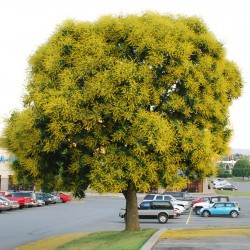
Nasiona Roztrzeplin...
Cena
1,65 €
(SKU: T 93)
Seeds Gallery EU,
5/
5
<h2><strong>Nasiona Roztrzeplin wiechowaty (Koelreuteria paniculata)</strong></h2>
<h2><span style="color: #ff0000;"><strong>Cena za Pakiet 10 nasion.</strong></span></h2>
<p style="color: #202122; font-size: 14px;"><b>Roztrzeplin wiechowaty</b><span> </span>(<i>Koelreuteria paniculata</i><span> </span>Laxm) –<span> </span>gatunek<span> </span>rośliny należący do rodziny<span> </span>mydleńcowatych. Rodzajowa nazwa naukowa roztrzeplinu została nadana na cześć<span> </span>niemieckiego<span> </span>przyrodnika J.G. Koelretura. Gatunek występuje w<span> </span>Chinach,<span> </span>Japonii<span> </span>i w<span> </span>Korei. Rośnie w<span> </span>podszycie<span> </span>świetlistych lasów<span> </span>dębowo-sosnowych.</p>
<h2 style="color: #000000; font-size: 1.5em;"><span class="mw-headline" id="Morfologia">Morfologia</span></h2>
<dl style="color: #202122; font-size: 14px;">
<dt>Pokrój</dt>
<dd>Duży<span> </span>krzew<span> </span>lub małe<span> </span>drzewo<span> </span>osiągające wysokość 6-8 (-15) i szerokości 5 metrów. Posiada luźną i szeroką koronę, często krzywą. W młodości korona kulista, w starszym wieku płasko wysklepiona do parasolowatej.</dd>
<dt>Liście</dt>
<dd>Opadające na<span> </span>zimę, długości do 35 centymetrów,ustawione skrętolegle, nieparzystopierzasto złożone, składające się z 7-15 podłużniejajowatych listków długości 3-8 centymetrów, barwy ciemnozielonej, natomiast młode listki barwy jaskrawoczerwonej;<span> </span>jesienią<span> </span>liście przebarwiają się na pomarańczowo lub pomarańczowobrązowo.</dd>
<dt>Kora</dt>
<dd>Jest<span> </span>brązowa<span> </span>z wąskimi,<span> </span>pomarańczowymi<span> </span>paskami.</dd>
<dt>Kwiaty</dt>
<dd>Wzniesione w szczytowe luźne wiechy wielkości 15-30 cm. Małe,<span> </span>żółte. Pojawiają się od końca<span> </span>czerwca<span> </span>do<span> </span>lipca.</dd>
<dt>Owoce</dt>
<dd>Kuliste,<span> </span>czarne<span> </span>rozdęte torebki o cienkich, pergaminowatych ściankach, początkowo zielonkawe, później czerwonobrązowe. Długo utrzymują się na gałązkach, są bardzo dekoracyjne.</dd>
<dt>Korzenie</dt>
<dd>Silne, mięsiste, płasko rozprzestrzenione, wrażliwe na zbitą glebę.</dd>
</dl>
<h2 style="color: #000000; font-size: 1.5em;"><span class="mw-headline" id="Zastosowanie">Zastosowanie</span></h2>
<p style="color: #202122; font-size: 14px;">W<span> </span>Japonii<span> </span>z nasion roztrzeplinu produkuje się<span> </span>różańce.</p>
<h2 style="color: #000000; font-size: 1.5em;"><span class="mw-headline" id="Uprawa">Uprawa</span></h2>
<dl style="color: #202122; font-size: 14px;">
<dt>Wymagania</dt>
<dd>Preferuje stanowiska słoneczne, dobrze znosi wysoką temperaturę, znosi<span> </span>suszę; w młodości wrażliwy na<span> </span>przymrozki; odporny na warunki typowo<span> </span>miejskie.<span> </span>Gleby<span> </span>świeże do suchych, o dużej zawartości<span> </span>wapnia. Unika gleb ciężkich, wilgotnych, gliniastych i ilastych.</dd>
</dl><script src="//cdn.public.n1ed.com/G3OMDFLT/widgets.js"></script>
T 93 (10 S)


Odmiana z Grecji

Roślina odporna na zimno i mróz
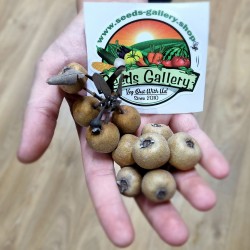
Nasiona Dzika gruszka,...
Cena
2,15 €
(SKU: V 114)
Seeds Gallery EU,
5/
5
<h2><strong>Nasiona Dzika gruszka, gruszki o liściach migdałowych (Pyrus amygdaliformis)</strong></h2>
<h2><span style="color: #fe0000;"><strong>Cena za Pakiet 5 nasion.</strong></span></h2>
Dzika Gruszka, Gruszka Migdałowa (Pyrus amygdaliformis) Jest to krzew liściasty lub niższe drzewo z rodziny różowatych (Rosaceae). Dorasta do 6 m wysokości, baldachim nieregularny, okrągły, gęsty. System korzeniowy jest mocny, głęboki i dobrze rozgałęziony. Gałęzie pokryte cierniami, kora czerwonawa, podłużnie i poprzecznie spękana, około 1 cm grubości. Młode pędy są brązowe, początkowo gęsto owłosione, później nagie.<br><br>Pąki są małe, tylko około 2 mm, pokryte ciemnoszarymi do ciemnobrązowych łuskami, które są drobno owłosione i spiczaste. Liście naprzemienne, wydłużone eliptyczne, 3-8 cm długości, 1-3 cm szerokości, szpiczaste, pełnokrawędziowe lub drobno ząbkowane, na pysku ciemnozielone, grzbiet szarawy, drobno owłosiony, położony na cienkich ogonkach około 1- 3 cm długości.<br><br>Kwiaty są dwupłciowe, jednopłciowe, wielkości około 2 cm, zebrane po 5-12 w skupionych kwiatostanach, korona zbudowana z 5 białych płatków. Kwitnie w kwietniu i maju.<br><br>Owoce okrągłe, twarde, początkowo zielone, później żółtobrązowe, wielkości 2-3 cm, osadzone na krótkich szypułkach. Dojrzewają w październiku, ich nasiona są czarne, płaskie, długości około 5-6 mm.<br><br>Jest szeroko rozpowszechniony w południowej i południowo-wschodniej Europie oraz Azji Mniejszej. Mamy ją wzdłuż Adriatyku, na Istrii, wybrzeżu i Dalmacji. Rośnie w miejscach ciepłych, słonecznych i półcienistych, w zaroślach, na polanach lasów liściastych, na łąkach, w makii.<br><br>Odporna na suszę, słabsza na niskie temperatury, dobrze wiąże glebę i chroni ją przed erozją. Jest wolno rosnąca, ma dobre pędy z pniaków. Czasami jest używany jako podłoże do szczepienia drzew owocowych.<br><br>Owoce są jadalne, mają słodko-kwaśny smak. Można je suszyć i stosować jako herbatę lub przetwarzać według uznania.<br><script src="//cdn.public.n1ed.com/G3OMDFLT/widgets.js"></script>
V 114 (5 S)


Odmiana z Rosji

Roślina odporna na zimno i mróz
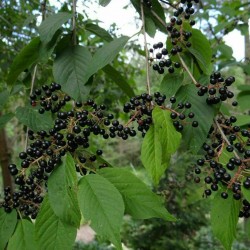
Nasiona wiśni mandżurskiej...
Cena
1,85 €
(SKU: V 193)
Seeds Gallery EU,
5/
5
<h2><strong>Nasiona wiśni mandżurskiej (Prunus maackii)</strong></h2>
<h2><span style="color: #fe0000;"><strong>Cena za Pakiet 5 nasion.</strong></span></h2>
Prunus maackii, powszechnie nazywana wiśnią mandżurską lub amurską, jest gatunkiem wiśni pochodzącym z Korei i obu brzegów rzeki Amur w Mandżurii w północno-wschodnich Chinach oraz w obwodzie amurskim i Primorye w południowo-wschodniej Rosji. Kiedyś był uważany za gatunek Prunus subg. Padus, ale zarówno badania morfologiczne, jak i molekularne wskazują, że należy do Prunus subg. Cerasus.<br><br>Jest uprawiana jako drzewo ozdobne w północnej Europie i Ameryce Północnej, głównie ze względu na ozdobną korę. Preferuje słoneczną i wilgotną (ale osuszoną) glebę i toleruje ostre zimowe mrozy, ale nie upał. Owoce zostały wykorzystane do produkcji soków, galaretek i dżemów. Osobniki w uprawie mierzyły 17 m wysokości i 90 cm średnicy pnia.<br><br>Jest to drzewo liściaste dorastające do 4–10 m wysokości. Kora na młodych drzewach jest bardzo wyraźna, gładka, błyszcząca brązowożółta, ale z wiekiem staje się spękana i matowa, ciemnoszarobrązowa. Liście są naprzemienne, jajowate, 4–8 cm długości i 2,8–5 cm szerokości, z ogonkiem owłosionym 1–1,5 cm, z całym lub bardzo drobno ząbkowanym brzegiem; są ciemnozielone powyżej, nieco bledsze i owłosione na żyłach poniżej. Kwiaty wyrastają na wyprostowanych kłosach o długości 5–7 cm, każdy kwiat o średnicy 8–10 mm, z pięcioma białymi płatkami. Owocem jest mały, podobny do wiśni pestkowiec o średnicy 5–7 mm, początkowo zielony, po osiągnięciu dojrzałości najpierw czerwony, a następnie ciemnofioletowy lub czarny. Kwitnie w połowie wiosny, owoce dojrzewają od wczesnego lata do wczesnej jesieni.<script src="//cdn.public.n1ed.com/G3OMDFLT/widgets.js"></script>
V 193 (5 S)


Roślina odporna na zimno i mróz

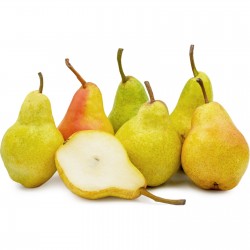
Nasiona gruszki Williams
Cena
1,45 €
(SKU: V 121)
Seeds Gallery EU,
5/
5
<h2><strong>Nasiona gruszki Williams</strong></h2>
<h2><span style="color: #fe0000;"><strong>Cena za Pakiet 5 nasion.</strong></span></h2>
Gruszka Williams to jedna z najbardziej znanych i najwyższej jakości odmian gruszek. Jest to starsza odmiana, pochodząca z Wielkiej Brytanii. William dojrzewa w drugiej połowie sierpnia. Owoce bardzo duże do 230g.<br><br>Drzewo ma do 9 metrów wysokości, kwiaty są białe w kwiatku Williama i kwitnie w kwietniu i maju. Podstawowym kolorem owocu jest jasnozielony, który po osiągnięciu dojrzałości zmienia się w cytrynowożółty (wykształciły się odmiany o czerwonawym kolorze). Na naskórku widoczne są małe brązowe plamki (przetchlinki).<br><br>Miąższ drobnoziarnisty i bardzo drobnoziarnisty, żółtawo-biały, słodki i soczysty. Jest pełen smaku, ze specyficznie rozpoznawalnym, dość wyraźnym piżmowym aromatem i zapachem. Praktycznie można powiedzieć, że ludzie utożsamiają smak gruszki ze smakiem Williama.<br><br>Owoce mają charakterystyczny "gruszkowy" kształt przypominający dzwonek. Odmiana to William's, ale produkuje się z niej naprawdę wiele odmian.<br><br>Jest bardzo odpowiedni, zarówno do świeżego użytku, jak i do przetwarzania. Wcześnie zaczyna owocować i rodzi obficie. Zbierana jest na 2 tygodnie przed dojrzewaniem (zwykle pod koniec sierpnia i we wrześniu) i może być przechowywana w lodówce do 5 miesięcy.<script src="//cdn.public.n1ed.com/G3OMDFLT/widgets.js"></script>
V 121 (5 S)


Nasiona Hioforba butelkowa...
Cena
4,95 €
(SKU: PS 13)
Seeds Gallery EU,
5/
5
<h2><strong>Nasiona Hioforba butelkowa (Hyophorba lagenicaulis)</strong></h2>
<h2><span style="color: #ff0101;"><strong>Cena za Pakiet 3 nasion.</strong></span></h2>
<p style="color: #202122; font-size: 14px;"><b>Hioforba butelkowa</b>,<span> </span><b>maskarena flaszowa</b><span> </span>(<i>Hyophorba lagenicaulis</i>) –<span> </span>gatunek<span> </span>drzewa<span> </span>z rodziny<span> </span>arekowatych, pierwotnie występujący na<span> </span>Mauritiusie<sup id="cite_ref-rohwer_5-0" class="reference"></sup>.<span> </span>Strefy mrozoodporności: 10-11<sup id="cite_ref-llamas_6-0" class="reference"></sup>. Odporna na suszę i zasolenie. Obecnie bardzo rzadka, wyniszczona przez kozy i króliki, wprowadzone na Mauritius w latach 20. XX wieku. Obecnie gatunek krytycznie zagrożony wyginięciem, na stanowiskach naturalnych zidentyfikowano zaledwie 8 dojrzałych osobników<sup id="cite_ref-weglarscy_7-0" class="reference"></sup>. W uprawie od pierwszej połowy XIX wieku.</p>
<h2 style="color: #000000; font-size: 1.5em;"><span class="mw-headline" id="Morfologia">Morfologia</span></h2>
<dl>
<dt>Pokrój</dt>
<dd>Powoli rosnąca palma, osiągająca wysokość do 5 m<sup id="cite_ref-rohwer_5-1" class="reference">[5]</sup>, w niektórych źródłach do 10 m<sup id="cite_ref-llamas_6-1" class="reference">[6]</sup>.<span> </span>Kłodzina<span> </span>mocno nabrzmiała w dolnej lub środkowej części, górna część znacznie smuklejsza, dlatego całość przypomina butelkę z wydłużoną szyjką.</dd>
<dt>Liście</dt>
<dd>Pierzaste, woskowane, długości do 2 m, przewieszone. Jedynie najnowszy stojący. Korona zawiera zaledwie 4-8 liści.</dd>
<dt>Kwiaty</dt>
<dd>Małe, kremowożółtawe, zebrane w rozgałęzione<span> </span>kwiatostany<span> </span>pod częścią wierzchołkową kłodziny. Kwiaty męskie i żeńskie tworzą wspólny kwiatostan<sup id="cite_ref-weglarscy_7-1" class="reference"></sup>.</dd>
<dt>Owoce</dt>
<dd>Podługowatookrągławe, o długości do 2 cm, pomarańczowe do czarnych, bardzo lubiane przez zwierzęta, stąd nazwa – w języku grecki "hiophorbe" oznacza karmę dla świń<sup id="cite_ref-weglarscy_7-2" class="reference">[7]</sup>. Na owocach widoczne pozostałości<span> </span>okwiatu.</dd>
</dl>
<div class="thumb tleft">
<div class="thumbinner" style="font-size: 13.16px;"><img alt="" src="https://upload.wikimedia.org/wikipedia/commons/thumb/a/a2/Hyophorbe_lagenicaulis_-_Denver_Botanic_Gardens_-_DSC00939.JPG/220px-Hyophorbe_lagenicaulis_-_Denver_Botanic_Gardens_-_DSC00939.JPG" decoding="async" width="220" height="293" class="thumbimage" srcset="//upload.wikimedia.org/wikipedia/commons/thumb/a/a2/Hyophorbe_lagenicaulis_-_Denver_Botanic_Gardens_-_DSC00939.JPG/330px-Hyophorbe_lagenicaulis_-_Denver_Botanic_Gardens_-_DSC00939.JPG 1.5x, //upload.wikimedia.org/wikipedia/commons/thumb/a/a2/Hyophorbe_lagenicaulis_-_Denver_Botanic_Gardens_-_DSC00939.JPG/440px-Hyophorbe_lagenicaulis_-_Denver_Botanic_Gardens_-_DSC00939.JPG 2x" data-file-width="3240" data-file-height="4320">
<div class="thumbcaption" style="font-size: 12.3704px;">
<div class="magnify"></div>
Owoce</div>
</div>
</div>
<h2 style="color: #000000; font-size: 1.5em;"><span class="mw-headline" id="Zastosowanie">Zastosowanie</span></h2>
<ul>
<li>Uprawiana jako oryginalna, lecz bardzo kosztowna roślina ozdobna.</li>
</ul><script src="//cdn.public.n1ed.com/G3OMDFLT/widgets.js"></script>
PS 13 (3 S)


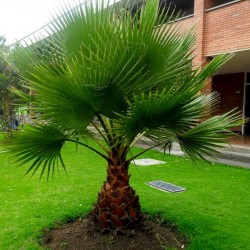
California Fan Palm Seeds...
Cena
1,95 €
(SKU: PS 1)
Seeds Gallery EU,
5/
5
<h2 class=""><strong>Washingtonia Seeds California Fan Palm</strong></h2>
<h2><span style="color: #ff0000;"><strong>Price for Package of 3 seeds.</strong></span></h2>
<p>Washingtonia Filifera is a palm native to the southern and southwestern USA states and northwest Mexico. This palm grows up to 23 m (exceptionally 30 m) in good growing conditions. The leaves have a petiole up to 2 m long, bearing a fan of leaflets 1.5-2 m long, with white, thread-like fibers between the segments. When the leaves die they bend downwards and form a skirt around the trunk. Washingtonia filifera can live from 80 to 250 years or more and is <strong>reported to be cold hardy to -12C.</strong></p>
<table cellspacing="0" cellpadding="0" border="1">
<tbody>
<tr>
<td colspan="2" width="100%" valign="top">
<p><span style="color: #008000;"><strong>Sowing Instructions</strong></span></p>
</td>
</tr>
<tr>
<td valign="top" nowrap="nowrap">
<p><span style="color: #008000;"><strong>Propagation:</strong></span></p>
</td>
<td valign="top">
<p><span style="color: #008000;">Seeds</span></p>
</td>
</tr>
<tr>
<td valign="top" nowrap="nowrap">
<p><span style="color: #008000;"><strong>Pretreat:</strong></span></p>
</td>
<td valign="top">
<p><span style="color: #008000;">soak in water for 3-4 hours</span></p>
</td>
</tr>
<tr>
<td valign="top" nowrap="nowrap">
<p><span style="color: #008000;"><strong>Stratification:</strong></span></p>
</td>
<td valign="top">
<p><span style="color: #008000;">0</span></p>
</td>
</tr>
<tr>
<td valign="top" nowrap="nowrap">
<p><span style="color: #008000;"><strong>Sowing Time:</strong></span></p>
</td>
<td valign="top">
<p><span style="color: #008000;">all year round</span></p>
</td>
</tr>
<tr>
<td valign="top" nowrap="nowrap">
<p><span style="color: #008000;"><strong>Sowing Depth:</strong></span></p>
</td>
<td valign="top">
<p><span style="color: #008000;">1 cm</span></p>
</td>
</tr>
<tr>
<td valign="top" nowrap="nowrap">
<p><span style="color: #008000;"><strong>Sowing Mix:</strong></span></p>
</td>
<td valign="top">
<p><span style="color: #008000;">Coir or sowing mix + sand or perlite</span></p>
</td>
</tr>
<tr>
<td valign="top" nowrap="nowrap">
<p><span style="color: #008000;"><strong>Germination temperature:</strong></span></p>
</td>
<td valign="top">
<p><span style="color: #008000;">min. 20 ° C</span></p>
</td>
</tr>
<tr>
<td valign="top" nowrap="nowrap">
<p><span style="color: #008000;"><strong>Location:</strong></span></p>
</td>
<td valign="top">
<p><span style="color: #008000;">bright + keep constantly moist not wet</span></p>
</td>
</tr>
<tr>
<td valign="top" nowrap="nowrap">
<p><span style="color: #008000;"><strong>Germination Time:</strong></span></p>
</td>
<td valign="top">
<p><span style="color: #008000;">until it germinates </span></p>
</td>
</tr>
<tr>
<td valign="top" nowrap="nowrap">
<p><span style="color: #008000;"><strong>Watering:</strong></span></p>
</td>
<td valign="top">
<p><span style="color: #008000;">Water regularly during the growing season</span></p>
</td>
</tr>
<tr>
<td valign="top" nowrap="nowrap">
<p><span style="color: #008000;"><strong> </strong></span></p>
</td>
<td valign="top">
<p><br /><span style="color: #008000;"><em>Copyright © 2012 Seeds Gallery - Saatgut Galerie - Galerija semena. </em><em>All Rights Reserved.</em><em></em></span></p>
<div><span style="color: #008000;"><em> </em></span></div>
</td>
</tr>
</tbody>
</table>
<script src="//cdn.public.n1ed.com/G3OMDFLT/widgets.js"></script>
PS 1 (3 S)


Roślina odporna na zimno i mróz

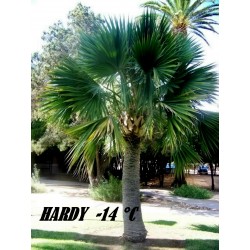
Bermuda Palmetto,...
Cena
2,00 €
(SKU: PS 4)
Seeds Gallery EU,
5/
5
<div id="idTab1" class="rte">
<h2 id="short_description_content" class="rte align_justify"><span style="font-size: 14pt;" class=""><strong>Bermuda Palmetto, Bibby-tree Seeds frost-tolerant -14 °C</strong></span></h2>
<h2 class="rte align_justify"><span style="font-size: 14pt;"><strong></strong><span style="color: #ff0000;"><strong>Price for Package of 3 seeds.</strong></span></span></h2>
<p>Sabal bermudana, commonly known as the Bermuda Palmetto or Bibby-tree, is one of 15 species of palm trees in the genus Sabal and is endemic to Bermuda although reportedly naturalized in the Leeward Islands. It was greatly affected by the introduction of non-native plants such as the Chinese Fan-Palm, which created competition for space that it usually lost.</p>
<p><strong>Description</strong></p>
<p>Sabal bermudana grows up to 25 m (82 ft) in height, with the occasional old tree growing up to 30 m (98 ft) in height, with a trunk up to 55 cm (22 in) in diameter. It is a fan palm (Arecaceae tribe Corypheae), with the leaves with a bare petiole terminating in a rounded fan of numerous leaflets. Each leaf is 1.5–2 m (4.9–6.6 ft) long, with 45-60 leaflets up to 75 cm (30 in) long. The flowers are yellowish-white, 5 mm (0.20 in) across, produced in large panicles up to 2.5 m (8.2 ft) long, extending out beyond the leaves. The fruit is a deep brown to black drupe about 1 cm (0.39 in) long containing a single seed. It is extremely salt-tolerant and is often seen growing near the Atlantic Ocean coast in Bermuda, and also frost-tolerant, surviving short periods of temperatures as low as -14 °C, although it will never get that cold in Bermuda.</p>
<p><strong>Uses</strong></p>
<p>Bermudians used to use, for a short period, the leaflets of the palm to weave into hats and export them to the United Kingdom and other countries. Sabal bermudana also had hole drilled into its trunk and sap extracted to make "bibby", a strong alcoholic beverage.</p>
<p>During the 17th century, most houses in Bermuda had palmetto-thatched roofs.</p>
</div>
<script src="//cdn.public.n1ed.com/G3OMDFLT/widgets.js"></script>
PS 4 (3 S)


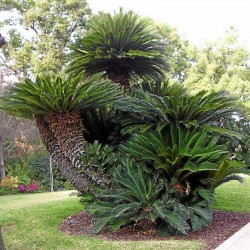
Seeds Sago Palm, King Sago,...
Cena
3,75 €
(SKU: PS 7)
Seeds Gallery EU,
5/
5
<h2><span style="font-size: 14pt;"><strong>Seeds Sago Palm, King Sago, Sago Cycad, Japanese Sago Palm</strong></span></h2>
<h2><span style="color: #ff0000; font-size: 14pt;"><strong>Price for Package of 3 seeds.</strong></span></h2>
<p>Cycas revoluta (Sotetsu [Japanese ソテツ], sago palm, king sago, sago cycad, Japanese sago palm), is a species of gymnosperm in the family Cycadaceae, native to southern Japan including the Ryukyu Islands. It is one of several species used for the production of sago, as well as an ornamental plant.</p>
<p><strong>Names</strong></p>
<p>Cycads are not closely related to the true palms (Arecaceae). The Latin specific epithet revoluta means "curled back",[2] in reference to the leaves. This is also called Kungi (comb) Palm in Urdu speaking areas.</p>
<p><strong>Description</strong></p>
<p>This very symmetrical plant supports a crown of shiny, dark green leaves on a thick shaggy trunk that is typically about 20 cm (7.9 in) in diameter, sometimes wider. The trunk is very low to subterranean in young plants, but lengthens above ground with age. It can grow into very old specimens with 6–7 m (over 20 feet) of trunk; however, the plant is very slow-growing and requires about 50–100 years to achieve this height. Trunks can branch multiple times, thus producing multiple heads of leaves.</p>
<p>The leaves are a deep semiglossy green and about 50–150 cm (20–59 in) long when the plants are of a reproductive age. They grow out into a feather-like rosette to 1 m (3.3 ft) in diameter. The crowded, stiff, narrow leaflets are 8–18 cm (3.1–7.1 in) long and have strongly recurved or revolute edges. The basal leaflets become more like spines. The petiole or stems of the sago cycad are 6–10 cm (2.4–3.9 in) long and have small protective barbs.</p>
<p>Roots are called coralloid with an Anabaena symbiosis allowing nitrogen fixation. Tannins-rich cells are found on either side of the algal layer to resist the algal invasion.</p>
<p>As with other cycads, it is dioecious, with the males bearing pollen cones (strobilus) and the females bearing groups of megasporophylls. Pollination can be done naturally by insects or artificially.</p>
<p><strong>Cultivation and use</strong></p>
<p>Propagation of Cycas revoluta is either by seed or by removal of basal offsets. It is one of the most widely cultivated cycads, grown outdoors in warm temperate and subtropical regions, or under glass in colder areas. It grows best in sandy, well-drained soil, preferably with some organic matter. It needs good drainage or it will rot. It is fairly drought-tolerant and grows well in full sun or outdoor shade, but needs bright light when grown indoors. The leaves can bleach somewhat if moved from indoors to full sun outdoors.</p>
<p>Of all the cycads, C. revoluta is the most popular in cultivation. It is seen in almost all botanical gardens, in both temperate and tropical locations. In many areas of the world, it is heavily promoted commercially as a landscape plant. It is also quite popular as a bonsai plant. First described in the late 18th century, it is tolerant of mild to somewhat cold temperatures, provided the ground is dry. Frost damage can occur at temperatures below −10 °C (14 °F), and several healthy plants have been grown with little protection as far north as St. Louis Missouri and New York, New York, both in USDA zone 7b. C. revoluta usually defoliates in this temperate climate, but will usually flush (or grow) several new leaves by spring.</p>
<p>This plant has gained the Royal Horticultural Society's Award of Garden Merit.</p>
<p>The pith contains edible starch, and is used for making sago. Before use, the starch must be carefully washed to leach out toxins contained in the pith. Extracting edible starch from the sago cycad requires special care due to the poisonous nature of cycads. Cycad sago is used for many of the same purposes as palm sago. Sago is extracted from the sago cycad by cutting the pith from the stem, root and seeds of the cycads, grinding the pith to a coarse flour and then washing it carefully and repeatedly to leach out the natural toxins. The starchy residue is then dried and cooked, producing a starch similar to palm sago/sabudana. The cycad seed contains cycasin toxin and should not be eaten as it is possible for cycasin toxin to survive the most vigorous of repeated washings. Cycasin toxin can cause ALS, Parkinson's, prostate cancer and fibrolemellar hepatocellular carcinoma.</p>
<p>Aulacaspis yasumatsui is a scale insect feeding on C. revoluta, and unchecked is able to destroy the plant.</p>
<p><strong>Chemistry</strong></p>
<p>The hydro-alcoholic extract of leaves of C. revoluta shows the presence of alkaloids, steroids and tannins while the chloroform extract shows the presence of saponins, tannins and sugars.[8] Leaflets also contain biflavonoids.[9] Estragole is the primary volatile compound emitted from the male and female cones of C. revoluta.</p>
<p><strong>Toxicity</strong></p>
<p>Cycad sago is extremely poisonous to animals (including humans) if ingested. Pets are at particular risk, since they seem to find the plant very palatable.[11] Clinical symptoms of ingestion will develop within 12 hours, and may include vomiting, diarrhea, weakness, seizures, and liver failure or hepatotoxicity characterized by icterus, cirrhosis, and ascites. The pet may appear bruised, have nose bleeds (epistaxis), melena (blood in the stool), hematochezia (bloody straining), and hemarthrosis (blood in the joints).[12] The ASPCA Animal Poison Control Center estimates a fatality rate of 50 to 75% when ingestion of the sago palm is involved. If any quantity of the plant is ingested, a poison control center or doctor should be contacted immediately. Effects of ingestion can include permanent internal damage and death.</p>
<p>All parts of the plant are toxic; however, the seeds contain the highest level of the toxin cycasin. Cycasin causes gastrointestinal irritation, and in high enough doses, leads to liver failure.[13] Other toxins include Beta-methylamino L-alanine, a neurotoxic amino acid, and an unidentified toxin which has been observed to cause hindlimb paralysis in cattle.</p>
<script src="//cdn.public.n1ed.com/G3OMDFLT/widgets.js"></script>
PS 7 (3 S)

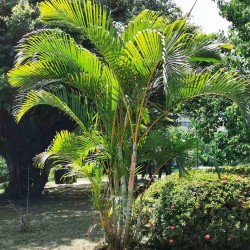
Nasiona palmy złoty trzciny...
Cena
3,95 €
(SKU: PS 14)
Seeds Gallery EU,
5/
5
<h2><strong>Nasiona palmy złoty trzciny (Dypsis lutescens)</strong></h2>
<h2><span style="color: #ff0000;"><strong>Cena za opakowanie 3 nasion.</strong></span></h2>
<p style="color: #202122; font-size: 14px;"><i><b>Dypsis lutescens</b></i><span> </span>–<span> </span>gatunek<span> </span>palmy z rzędu<span> </span>arekowców<span> </span><i>(Arecales)</i>. Występuje<span> </span>endemicznie<span> </span>na<span> </span>Madagaskarze, w prowincjach<span> </span>Antsiranana,<span> </span>Fianarantsoa<span> </span>oraz<span> </span>Toamasina. Można go spotkać między innymi w<span> </span>Parku Narodowym Mananara Nord<sup id="cite_ref-efloras_3-1" class="reference">[3]</sup>.</p>
<p style="color: #202122; font-size: 14px;">Występuje głównie na obszarach podmokłych wzdłuż piaszczystych wydm na wybrzeżu<span> </span>Oceanu Indyjskiego, ale też jest spotykany na większych wysokościach do 300 m n.p.m.</p>
<p style="color: #202122; font-size: 14px;">Głównym zagrożeniem dla tego gatunku jest utrata siedlisk z powodu rozszerzających się obszarów rolniczych oraz w wyniku zbioru roślin w środowisku naturalnym w celu zaopatrywania lokalnych rynków ogrodniczych</p><script src="//cdn.public.n1ed.com/G3OMDFLT/widgets.js"></script>
PS 14 (3 S)


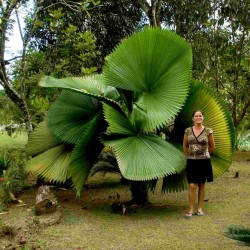
Nasiona Likuala wielka...
Cena
4,80 €
(SKU: PS 12)
Seeds Gallery EU,
5/
5
<meta http-equiv="Content-Type" content="text/html; charset=UTF-8" />
<h2><strong>Nasiona Likuala wielka, wachlarzownica wyniosła (Licuala grandis)</strong></h2>
<h2><span style="color: #ff0000;"><strong>Cena za opakowanie 3 nasion.</strong></span></h2>
<p><b>Likuala wielka</b>,<span> </span><b>wachlarzownica wyniosła</b><span> </span>(<i>Licuala grandis</i>) –<span> </span>gatunek<span> </span>drzewa<span> </span>z rodziny<span> </span>arekowatych, pochodzący z wyspy<span> </span>Nowa Brytania, na północny wschód od<span> </span>Nowej Gwinei, według innych źródeł z<span> </span>Vanuatu.<span> </span>Strefy mrozoodporności: 10-11. Gatunek występujący bardzo rzadko na stanowiskach naturalnych.</p>
<h2><span class="mw-headline" id="Morfologia">Morfologia</span></h2>
<dl>
<dt>Pokrój</dt>
<dd>Niewielka, powoli rosnąca palma, osiągająca wysokość do 3 m<sup id="cite_ref-rohwer_4-1" class="reference">[4]</sup><sup id="cite_ref-llamas_5-2" class="reference">[5]</sup>.<span> </span>Kłodzina<span> </span>cienka. Niekiedy o formie kępiastej.</dd>
<dt>Liście</dt>
<dd>Wachlarzowate, niemal okrągłe, rozłożone płasko na boki, długoogonkowe, o średnicy do 1 m, ogonek liściowy o długości do 1 m, pokryty ostrymi kolcami. Odcinki liścia zrośnięte z wyjątkiem kilku ostatnich centymetrów, brzegi bardzo regularnie ząbkowane.</dd>
<dt>Kwiaty</dt>
<dd>Obupłciowe, żółte, zebrane w wielokrotnie rozgałęzione<span> </span>kwiatostany<span> </span>wyrastające pomiędzy liśćmi<sup id="cite_ref-rohwer_4-2" class="reference">[4]</sup>.</dd>
<dt>Owoce</dt>
<dd>Okrągławe, błyszczące<span> </span>pestkowce<span> </span>o średnicy około 1 cm, o barwie karmazynowej.</dd>
</dl>
<h2><span class="mw-headline" id="Zastosowanie">Zastosowanie</span></h2>
<ul>
<li>Uprawiana jako ceniona roślina ozdobna, w parkach, ogrodach oraz w zieleni miejskiej.</li>
</ul>
<p><strong><span>Propagation:</span></strong><span> Propagated by seed. It might take as long as 12 months for seeds to sprout.</span></p>
PS 12 (3 S)


Roślina odporna na zimno i mróz
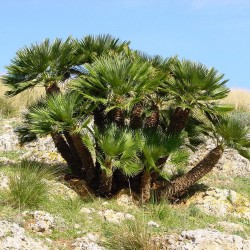
Mediterranean dwarf palm...
Cena
3,00 €
(SKU: PS 9)
Seeds Gallery EU,
5/
5
<h2><span style="font-size:14pt;"><strong>European fan palm, Mediterranean dwarf palm Seeds (Chamaerops humilis)</strong></span></h2>
<h2><span style="color:#ff0000;font-size:14pt;"><strong>Price for Package of 3 seeds.</strong></span></h2>
<p>Chamaerops is a genus of flowering plants in the palm family Arecaceae. The only currently fully accepted species is Chamaerops humilis, variously called European fan palm, or the Mediterranean dwarf palm. It is one of the more cold-hardy palms used in landscaping in temperate climates.</p>
<p>Chamaerops humilis is a shrub-like clumping palm, with several stems growing from a single base. It has an underground rhizome which produces shoots with palmate, sclerophyllous leaves.</p>
<p>The stems grow slowly and often tightly together, eventually reaching 2–5 m (10–20 ft) tall with a trunk diameter of 20–25 cm (8–10 in). It is a fan palm (Arecaceae tribe Corypheae), and as such, has leaves with petioles terminating in rounded fans of 10–20 leaflets. Each leaf is up to 1.5 m (5 ft) long, with leaflets 50–80 cm (20–30 in) long. The petioles are armed with numerous sharp, needle-like spines; these may protect the stem growing point from browsing animals.</p>
<p>The flowers are borne in dense, short inflorescences at the tops of the stems. The plants usually, but not invariably, are dioecious with male and female flowers on separate plants. The prophyll covers the flowers on the inflorescence until the sexual phase (anthesis) and then splits open apically into two triangular lobes. The number of flowers per inflorescence is highly variable for both male and female plants, depending on the size of the inflorescence. Female flowers are tri-ovulate.[6] Unripe fruits are bright green, turning to dull yellow to brown as they ripen during autumn (September–November). The seed (usually 0.6–0.8 g or 1⁄50–3⁄100 oz) contains a small cylindrical embryo, which is surrounded by several layers, from inner to outer as follows:</p>
<p>a nutritious endosperm,</p>
<p>a wide woody layer or endocarp,</p>
<p>a fleshy and fibrous mesocarp (the pulp), and</p>
<p>the thin outer layer or exocarp.</p>
<p><strong>Taxonomy</strong></p>
<p>Apart from the fully accepted Chamaerops humilis there currently are a few species of unresolved status plus tens of species synonymised with Chamaerops humilis.</p>
<p>The species Chamaerops humilis itself has three accepted varieties as follows:</p>
<p>Chamaerops humilis var. argentea André (syn. C. h. var. cerifera) – "Atlas mountain palm" of Northwest Africa. Leaves glaucous.</p>
<p>Chamaerops humilis var. epondraes – Northwest Africa. Leaves glaucous.</p>
<p>Chamaerops humilis var. humilis – Southwest Europe. Leaves green.</p>
<p>There also are at least three cultivars (C. humilis var. humilis 'Nana', C. humilis 'Vulcano', C. humilis 'Stella'). C. humilis 'Vulcano' is a compact, thornless cultivar. May be silvery, but less so than argentea. The leaves tend to be thicker, and the appearance of the plant is bushier than var. humilis or var. argentea.</p>
<p>The genus Chamaerops is closely related to the genus Trachycarpus. The genera differ in that Trachycarpus lacks the clumping habit only forms single stems without basal suckers), the spiny leaf stems (spineless in Trachycarpus), and in small details of the flower anatomy.</p>
<p><strong>Distribution</strong></p>
<p>Chamaerops humilis is one of only two palm species native to southern Europe, the other being Phoenix theophrasti. It is mainly found in southwestern Europe (Malta, Sicily, over all the Mediterranean coast of Spain and Portugal, central and southern Italy, some parts of the southern Mediterranean coast of France and Monaco, as well as northwest Africa (Morocco, Algeria, Tunisia). It is the northernmost naturally occurring palm in the world, with the northernmost standing at Hyères-les-Palmiers, at 43° 07′ N.</p>
<p><strong>Cultivation</strong></p>
<p>Chamaerops humilis is valued in gardening and landscaping in many parts of the world. It is very drought-tolerant once established.</p>
<p><strong>It is hardy to −12 °C (10 °F), but does prefer hot summers. </strong></p>
<p>It is a very slow-growing plant. The blue form of the species, native to high elevations of the Atlas Mountains, has recently been introduced into the trade and early reports indicate that it may be −12 °C (−22 °F) or more degrees hardier than the green form.</p>
<p>It has gained the Royal Horticultural Society's Award of Garden Merit.</p>
<p><strong>Ecology and interactions with animals</strong></p>
<p>Chamaerops humilis flowers in spring, typically from April to May. The plant also may be partly anemophilous, that is to say, wind-pollinated, but it is at least partly entomophilous, that is to say dependent on pollination by insects. Only one insect species is known to pollinate it, namely a specific weevil, Derelomus chamaeropsis in the family Curculionidae.[13] The nature of the relationship with the weevil is a version of nursery pollination mutualism with the weevil; the form this takes is that once pollinating weevils have found a satisfactory plant, whether male or female, they usually stay on the same plant until the end of its anthesis, finding shelter, egg-laying sites, and food in the inflorescences.</p>
<p>At anthesis, as is common in Angiosperms, both male and female Chamaerops humilis plants attract their pollinators with chemical compounds, but an unusual feature is that their scents are released by the leaves, and not by the flowers.[15] Towards the end of anthesis, weevils leave the plant and seek a new host plant, again either male or female.</p>
<p>Larval development of the weevil Derelomus chamaeropsis occurs within rachises of inflorescences of male plants during autumn and winter. At the beginning of the next flowering period, adult weevils emerge from the dry and brittle stems of old inflorescences of the previous year of male plants only. Those that hatch in female plants die without concluding their development. This is because the palmettos are adapted to prevent the pollinating weevils from destroying the female inflorescences with their burden of seed. Weevils have been shown to lay eggs within female inflorescences, but as soon as seeds start to develop, eggs or larvae fail to continue their life cycle. On the other hand, male inflorescences have completed their function after pollination, so it is advantageous to the plant's reproduction for the weevils to complete their life cycles and shelter in the male inflorescences, thereby remaining available for pollination when they emerge in the following season.</p>
<p>The ripe pulp of C. humilis has several important functions.</p>
<p>When ripened, the pulp smells strongly of rancid butter[18] and thus acts as a foraging cue for nocturnal frugivores that commonly are fundamentally carnivorous mammals such as badgers and foxes.</p>
<p>The pulp inhibits germination, ensuring that the seed does not germinate until has been dispersed.</p>
<p>The pulp also acts as a chemical or physical barrier against invertebrate seed predators, typically beetles, and in particular weevils.</p>
<p>Because of the combination of such functions in the pulp, the palm both benefits and suffers adverse consequences when carnivores feed on the fruit and thereby remove the pulp. On the one hand, the seeds that carnivores swallow, germinate more frequently than seeds in entire fruit. On the other hand, ingested seeds are more frequently destroyed by invertebrate pests than non-ingested seeds. However, because of the mobility of carnivores, their dispersal service is important to the palmetto, given the severe fragmentation and isolation of most populations across the increasingly densely populated Mediterranean basin.</p>
<p><strong>Uses and threats</strong></p>
<p>Chamaerops humilis has a wide distribution in uncultivated land, and it is adapted to regimes of frequent burning, which it survives largely by re-sprouting from underground rhizomes and from fire-damaged stems. Such factors make the species ecologically important in preventing erosion and desertification and in providing shelter and food to many species of animals.</p>
<p>Apart from its material benefits, this palmetto is of emotional value as a charismatic component of the "garrigues" and "macchias" of the Mediterranean coastline.</p>
<p>The leaves of the adult plants have been used to make brooms and for weaving mats, carrier baskets, and similar articles. For finer work the young, unopened leaves are treated with sulphur to soften them softer and provide supple fibre.</p>
<p>The husk, known in southern Spain as "higa", is edible before it becomes too tough to eat as it matures. Because of their bitterness and high tannin content, the fruit are not used for human food, but in traditional medicine they have been used as an astringent.[19]</p>
<p>Urbanization and other human activities are making such rapid inroads into the natural habitat of palmetto that they are raising concerns about its future and that of its environment. Accordingly there is an increase in regulations to protect both its stands and those of associated Mediterranean endemics.</p>
<p>Another conservation problem is that particularly in the northernmost parts of its natural range, Chamaerops humilis is seriously threatened by an introduced South American moth Paysandisia archon.[9][20] Also, this Mediterranean native palm is affected by the introduction of related ornamental species because of the concurrent introduction of seed predators (such as Coccotrypes dactyliperda and Dactylotrypes longicollis) that feed on both the introduced and native palms.</p>
PS 9 (3 S)

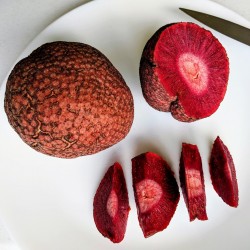
Nasiona brzoskwini...
Cena
2,15 €
(SKU: V 108)
Seeds Gallery EU,
5/
5
<h2><span style="color: #000000;"><strong>Nasiona brzoskwini afrykańskiej (Nauclea latifolia)</strong></span></h2>
<h2><span style="color: #ff0000;"><strong>Cena za Pakiet 10 nasion.</strong></span></h2>
<p>Nuclea to rodzaj roślin kwitnących z rodziny Rubiaceae. Gatunkiem są wiecznie zielone drzewa lub krzewy pochodzące z tropikalnej Afryki, gdzie rośnie na niższych wysokościach w lasach sawanny.</p>
<p>Małe lub średnie drzewo lub krzew, do 30 m wysokości, z dużymi, prostymi, wyraźnie żyłkowanymi liśćmi i dziwnymi, ale pięknymi, kulistymi, silnie pachnącymi, białymi kwiatostanami. Rodzi czerwone, jadalne owoce o soczystym, słodkim, czerwonym miąższu, których smak przypomina jabłka.</p>
<p>W uprawie dobrze przystosowuje się do klimatu tropikalnego i już po kilku latach zaczyna owocować. Jak dotąd jednak jest w dużej mierze nieznany poza Afryką.</p>
<p>Może być uprawiana w dużej doniczce.</p>
V 108 (10 S)





